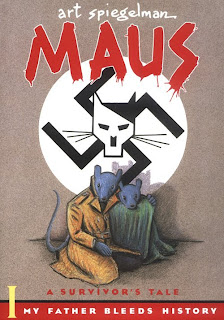 Originally published as individual chapters in RAW Magazine from 1980 until 1991, Maus is two parallel narratives. One is the story of the strained relationship between Art Spiegelman and his father Vladek. Art is a child of the 1960s, rebellious, troubled, and at-odds with his stubborn, parsimonious, and argumentative dad. The second story is the tale of how Vladek navigated life during Hitler's rise and rule in Europe. This volume covers much of his life before World War II, when he was coming up in the world, wooing women, and making a family of his own.
Originally published as individual chapters in RAW Magazine from 1980 until 1991, Maus is two parallel narratives. One is the story of the strained relationship between Art Spiegelman and his father Vladek. Art is a child of the 1960s, rebellious, troubled, and at-odds with his stubborn, parsimonious, and argumentative dad. The second story is the tale of how Vladek navigated life during Hitler's rise and rule in Europe. This volume covers much of his life before World War II, when he was coming up in the world, wooing women, and making a family of his own.This volume contains the first 6 chapters of the tale. The story is framed in anthropomorphic terms, with Jews being mice and Germans being cats. The symbolism is immediately evident as a predator/prey relationship, a deadly serious version of a Tom and Jerry cartoon. For those interested in the symbolism, Spiegelman explains his artistic choices in this interview with J. Stephen Bolhafner.
A prolific artist with many works to his credit, Art Spiegelman began doing comics work in the 1970s at the tail end of the underground comix movement. Aside from creating anthologies such as Arcade and RAW, he also worked for Topps Bubble Gum for 20 years where he had a hand in creating such products as the Wacky Packages stickers and Garbage Pail Kids trading cards. He went on to draw a number of controversial covers for the New Yorker magazine in the 1990s and 2000s, and with his wife Françoise Mouly he currently runs a company that makes graphic books for children, TOON Books.
Maus is one of the most celebrated graphic novels ever. It is usually the example most used when people argue that comics and graphic novels have "grown up." It is also credited in large part for raising graphic novels into prominence as more than "just glorified comic books." This volume won a 1986 National Book Critics Circle Award and is generally held in high regard by readers, as seen in this range of reviews from Goodreads. Maus is commonly taught and read in high schools and universities as well.
Still, there is also backlash to the story. Some readers see Spiegelman exploiting his father's holocaust experiences for profit. Political cartoonist and controversy lightning rod Ted Rall criticized Spiegelman's work in Maus as facile and one-dimensional in this 1999 Village Voice article. Such criticisms may be few, but they are loud ones.
Some preview pages from this volume are available on this page from its current US publisher Pantheon, a division of Random House.
Views: 49
Replies to This Discussion
-
To see the rest of my blog, please visit: http://graphicnovelresources.blogspot.com/
-
-
Stergios, thank you so much for sharing this!! Keep your great posts coming!!! BTW - for those looking for some Maus study materials - Random House has a teacher's guide you can check out here.. And while there are bazillions of holocaust resources, I just caught this moving show on NPR's "The Story" yesterday (the 65 anniversary of the libration of the camps) that nicely dovetails with the specifics of Maus:
Today is the 65th anniversary of the liberation of Auschwitz. It has become known as International Holocaust Remembrance Day. Eva Kor is at the camp in Poland today with a group of teachers, students, and others. Eva was one of the twins who survived the experiments of Nazi doctor Joseph Mengele at Auschwitz. For years she was filled with anger and hatred over her ordeal. But meeting a Nazi doctor changed everything. She forgave that man, and even forgave Dr. Mengele. But her decision doesn’t sit well with some Holocaust survivors. Eva talks with Dick about her experiences during the Holocaust and how forgiveness changed her life.
Podcast = http://thestory.org/archive/the_story_959_Haiti_Partners_.mp3/view -
© 2025 Created by Ryan Goble.
Powered by
![]()